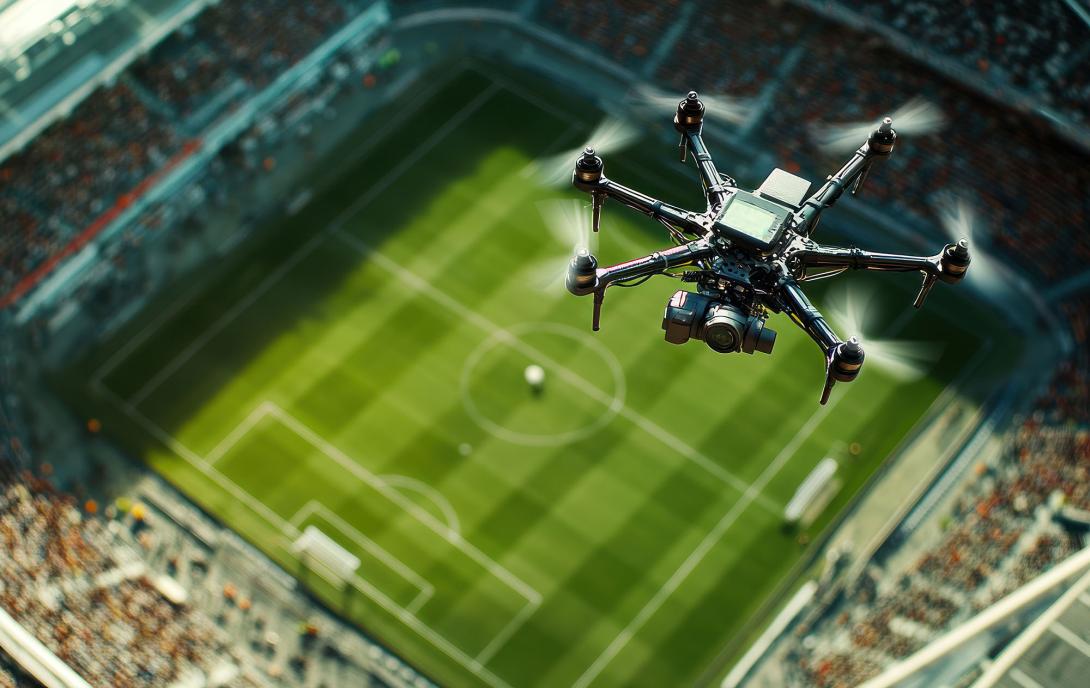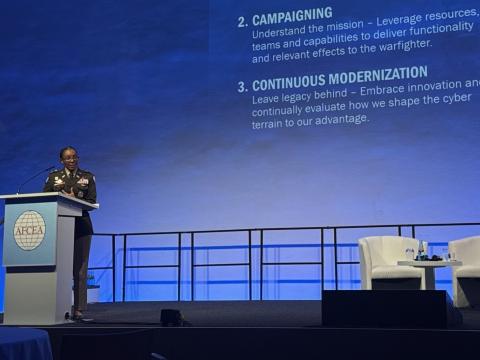Drones and the Goal Toward a Safe FIFA 2026
As North America looks forward to the largest FIFA World Cup in history, security experts prepare for all possible security threats, including those from emerging technology. As the use of unmanned aerial systems (UAS) grows in popularity, so do the risks. The greatest challenge lies in capacity and interoperability.
“We don’t have the training, we don’t have the equipment, and we don’t have the number of personnel that are skilled in mitigation technology and the use of mitigation technology, particularly the application of that technology in really highly dense radio frequency environments or urban environment,” said G.B. Jones, chief safety and security officer for the FIFA World Cup 2026.
Jones’ experience in aerial and aviation security is extensive, with 23 years serving the FBI, and supervising the FBI Joint Terrorism Task Force during the 9/11 attacks. Most recently, Jones was the international security director for the National Football League.
Currently, only federal government authorities have the authority to mitigate drones using counter-UAS tools, Jones told SIGNAL Media in an interview, highlighting his main concern. Therefore, his team is working with legislators and the current administration to enhance capabilities for state, local, tribal and territorial first responder teams, enabling them to operate technology to mitigate drone threats.
Since taking office, the Trump administration and the National Security Council have leveraged executive orders to enable additional federal personnel to mitigate the emerging threat, Jones explained.
“In that vein, they have leaned forward and they’ve asked the FBI to host a class for state, local, tribal and territorial personnel, and they’re focusing on World Cup cities,” Jones added. The first class was set to take place in October.
“Once the training is done, there will be more people capable of using the technology. Then, the legislative authority needs to step up and expand the use of that technology, so we’ll have a larger cadre of people who are able to do it. We’ll have more equipment ... in the field [to be] used,” Jones continued. “The last step would be getting the authorities into their hands to actually allow them to do it in the face of threat.”
In terms of threats posed by UAS, the possibilities are far-reaching, according to Lt. Col. Albert Sciarretta, USA (Ret.), a counter-small UAS (C-sUAS) subject matter expert with decades of military and industry experience.
During a conversation with SIGNAL Media, Sciarretta listed three types of drone use cases: television station and FIFA drones, hobbyist drones, and nefarious drones.
With all three drone types, the possibility of a mechanical or power issue is a problem, as the drone could fall to the ground and risk hurting someone. Most hobby drones, however, are designed to either land or return to their launch location when the battery is running low. “That’s a good safety note, but not all of them work properly, and sometimes you get rogue drones that do their own thing, so you have to worry about that,” Sciarretta continued.
Still, nefarious drones carry the most consequential threats to public safety.
“A drone could … just start jamming transmissions, causing havoc in that respect, and it could jam transmissions for local security forces, or they could jam them just to affect the transmission of the events themselves and cause problems for the television stations,” Sciarretta said.
“I would say if they were going to use it in a nefarious way, they’d want to jam the transmissions of the first responders,” he said.
Another threat from sUAS is the speed at which they fly, some reaching 90 miles per hour. Even for propeller drones, the maximum speed of 30 miles per hour could cause damage, Sciarretta pointed out.
The most significant danger comes from drones carrying—and dropping—harmful items such as explosives or chemicals, he added, which is why safety and mitigation protocols should be in place.
“How you stop them is a real problem in the United States, and the reason why is that there are a lot of [Federal Communications Commission (FCC)] and [Federal Aviation Administration (FAA)] restrictions,” Sciarretta stated.
Unlike in combat zones, where a drone’s signal can be jammed for the operator to lose control, the FCC does not allow such mitigation tactics in cities or near airports. “You could cause problems by jamming those signals because they’re commercial radio frequencies that are being used by other systems ...”
Similarly, the FAA does not allow drones to be shot down, as that could cause much more damage.
Some off-the-shelf drones also have a built-in safety system that knows to avoid restricted areas, Sciarretta noted. “The drone may take off slightly, but then … it’ll land because you’re within the range of the restricted area.”
Another less lethal mitigation tactic is spoofing, Sciarretta said. “You could manipulate the drone to think that it’s in a different location,” he said, a strategy that would require sending different signals to the drone to make it land in a safe location. While this approach works well, there are still FAA and FCC restrictions that require their approval for such operations.
Even for drones operated by the FBI or state police, FAA and FCC approval is necessary, a process that could take months.
“The biggest challenge you have is detecting the drones and tracking them,” Sciarretta stated. First, out of all the drones being flown by hobbyists, bloggers and federal agents, there’s difficulty in identifying the threat.
While radar is a great source for tracking larger objects such as airplanes, drones are too small to detect, he said. “What you have to do is tune the radar down to pick up something the size of a hobby drone, and that can be done. The problem, though, is now you’re going to pick up birds and maybe leaves blowing in the trees or other things like that,” Sciarretta pointed out. In this case, an artificial intelligence-powered radar system could be beneficial in identifying a drone, he added.
“Another way of detecting drones is to use [radio frequency (RF)] signals,” Sciarretta suggested. A drone will usually transmit information like images, live feeds and location back to its operator. “If you could pick up those signals and if you had at least three sensors to detect RF signals placed in the area and they’re scattered, what you do is you get a detection, you get an angle of the transmission from the drone for all three of them and you draw a line, and where the three intersect, that gives you an idea of where the drone might be.”
However, a cluttered environment due to buildings and large structures could present a new challenge. “Those signals from the drone may be bouncing off the structures, so the receiver, the sensors picking up the RF transmissions ... may pick up the reflections, and the reflections will cause inaccuracies,” Sciarretta further explained.
The triangulation system could therefore show an erratic flight path for the drone. “Radio transmissions can be sensed and can be used, and with some manipulation, you can null out some of those inaccuracies and maybe get a decent track, and you can add more sensors, and the more you have, the more lines you have to intersect.”
Notably, some drone companies are implementing automatic frequency switch capabilities within their devices. So, in the case where a certain frequency gets jammed, the drone can continue flying by switching to another.
“Also, if I’m tracking it on a particular frequency and it switches, then I’ve lost it and I have to reacquire it on a new frequency, so that adds some complexity to these RF sensors that are being used to detect and track the drones,” Sciarretta said. Although some companies are building detectors for those situations, the federal restrictions still make the issue more complicated, he added.
Acoustic sensors could also help in drone detection, but their limited range makes them less reliable, especially in extremely cluttered environments where other sounds could resemble that of a drone.
Some drone companies have also made their own detection components, which can identify and track the drones within their service. This type of capability could be emulated by foreign companies and used for malicious intent, Sciarretta stated.
The Department of Homeland Security Science and Technology Directorate, or DHS S&T, is therefore evaluating ways to leverage advanced technology to mitigate UAS threats. “This includes radar, [RF] sensors, and optical technologies, as well as kinetic solutions that provide real-time situational awareness of UAS activity,” said DHS S&T’s Shane Cullen.
In June, Cullen’s team used Philadelphia to conduct a C-UAS exercise in an operational environment. “Testing events like these are critical for validating technology effectiveness, identifying gaps and refining operational protocols,” he wrote in an email.
The ease of access to drones makes matters more complex, with some even using do-it-yourself tactics to build sUAS. Certain websites offer tips for fixing the drones, Sciarretta said. “I’m sure that folks like the FBI will be tracking who’s connecting to DIYdrones.com and what questions they’re asking,” he said, but challenges remain.
Meanwhile, ‘good’ operators could control their drones to secure an area. “I was conducting a test once where we were worried about test drones going rogue and we would lose control over them,” Sciarretta presented. A drone racer would then enter the field with his 60-mph drone and hit the top of the propeller of the rogue drone to make it fall to the ground. The option does leave the risk of causing more harm by hitting the ground, however.
“What if they use the same concept and instead of knocking [the rogue drone] down, the [racer] drone has some sort of net underneath it and it wraps the net around the drone and pulls it away,” Sciarretta suggested.
Additionally, drones can be used to collect and provide intelligence and reconnaissance information.
“What if while the drone’s being flown, the location of the operator is given to local security forces? They could go to that location and arrest the operator while flying the drone,” Sciarretta added. Similarly, a drone could be used by federal agents to fly to the operator’s location and distract him until law enforcement arrives.
All these operations would require faultless interoperability between FIFA, federal agencies and local law enforcement, he stressed.
“The good news is, particularly at the state and local levels, we’re beginning to see change,” said John Cohen, executive director of the Center for Internet Security. It is essential for law enforcement to act at the speed of rapid innovation, he stressed. In preparation for large-scale nationwide events, collaboration between chief information security officers, first responders and law enforcement agencies is paramount—and it is happening.
“They will walk through these types of integrated threat scenarios and develop operational plans that bring together and establish lines of communication between all of these different sectors,” Cohen explained. Still, for events like FIFA World Cup 2026, domain awareness of all participating locations, including hotels, transportation hubs and viewing events, is vital.
The public’s job is to remain aware and trust that law enforcement is there and is focused on the problem, Cohen assured.
“This is the largest World Cup in history. It’s the largest sporting event in the world, and as such, there are going to be some fairly stringent security protocols,” Jones said. “We also want to embrace security and technology for positive use, so in limited circumstances, we will be using drones. If you’re not a commercial operator working directly with FIFA, please leave your drone at home. There’s no room for you here.”





Comments